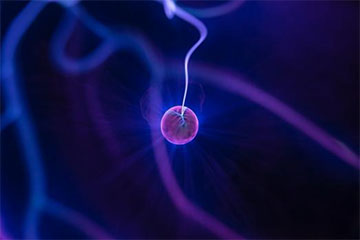
[Image: Zoltan Tasi on Unsplash]
Physicists in China have shown how to image a single cold atom with a resolution beyond the diffraction limit and on timescales of just a few tens of nanoseconds. They say their new microscopy scheme should allow scientists in future to probe the spatial and dynamical properties of cold atom systems with great precision (Phys. Rev. Lett., doi:10.1103/PhysRevLett.127.263603).
Chasing cold atoms
Cold atoms, whether in the form of gases or individual neutral or charged particles, hold great promise as the basis for quantum technologies such as computation, simulation and sensing. But their exploitation relies on obtaining direct information about atoms’ transport, correlations and other properties, which in turn depends on being able to detect and image individual particles. A number of microscope techniques have been developed to do this, but the resolution of these methods is constrained to be no better than the optical diffraction limit.
At the same time, chemists and biologists use a range of super-resolution microscopy techniques to investigate chemical reactions and other processes on the nanometer scale. One such technique, known as stimulated emission depletion (STED) microscopy, involves using two separate lasers to generate fluorescence from fluorophores over a very small area. One laser initiates the fluorescence and the other then deactivates that emission over all but a tiny central area—enabling a resolution superior to that obtainable with the first laser alone.
Physicists have also exploited this technique, using it to image quantum systems such as collections of spins in solid-state materials or single ions. What’s more, some have started using it with cold atoms. Until now, however, no one had employed the technique to detect a single such atom at resolutions below the diffraction limit.
Three-step process
In the latest work, Guang-Can Guo and colleagues at the University of Science and Technology of China in Hefei show how to image a single cold ion by combining STED with quantum-state transition control. Their setup involves confining an ion of ytterbium-171 in a radio-frequency trap and exposing it to three laser beams. Cylindrically shaped “initialization” and “detection” beams enter the trap via side windows in the surrounding vacuum chamber (which is also exposed to a magnetic field). A doughnut-shaped “depletion” beam, in contrast, enters from above—being focused to a tiny spot inside the trap by a lens.
The imaging process relies on three steps. First, the initialization beam polarizes the ion’s nuclear spin and leaves the particle in the lower of two possible spin states. Next, the depletion beam moves the ion to the higher spin state—assuming that the beam is touching the ion. The final step then sees photons from the detection beam scattered by the ion if it was left in the upper, or “light,” spin state while no scattering takes place for the lower “dark” state.
This process is used to build up an image of the ion’s environment pixel by pixel, by scanning the focus of the depletion beam across a two-dimensional grid and repeating the three steps at each grid point. Only when the ion lies inside the depletion doughnut does it remain dark—the signal that the ion has been found.
Leveraging holography
This technique requires the depletion beam to be highly focused and have strong intensity contrast between doughnut and hole. To satisfy these conditions and produce a perfect dark-center depletion spot, the researchers took advantage of a holographic beam reshaping method with a so-called digital micromirror device.
Doing so, they found they could indeed generate a super-resolved image of a single trapped ion. Using a lens with a numerical aperture of 0.1, they achieved resolutions down to 175 nm, which, they say, is at least ten times better than that of direct fluorescence imaging.
Guo and colleagues also studied the ion’s dynamics by applying a resonant electrical signal to one of the trap’s electrodes, switching off the signal and then waiting a certain amount of time before imaging one of the pixels. By carrying out this process across all the pixels for a given delay and then repeating the exercise at different delays, the researchers were able to reconstruct the ion’s trajectory—the snapshots being just 80 ns apart and having a spatial precision of 10 nm.
Further improvements
The researchers say their scheme could also be applied to neutral particles, such as single atoms trapped in an optical tweezer. What’s more, they add, by generating an arbitrary array of spots with various shapes and using them to image cold-atom arrays, it should be possible to probe the correlations between different atoms (something that will require them to update their trap so that it can hold multiple ions).
They also reckon that the technique’s resolution could be further improved by using lenses with higher numerical apertures. They say that apertures as big as 0.6 and 0.7 have been made for trapped ions and cold neutral atoms respectively, although they point out that no existing commercial lenses with such apertures can compensate for the aberration introduced by the window in their vacuum chamber.
Should the researchers be able to develop or procure such lenses, they could in principle achieve resolutions below 30 nm and displacement accuracies of less than 2 nm. This latter figure, they note, is smaller than the size of the wave packet of the trapped ion’s motional ground state.
